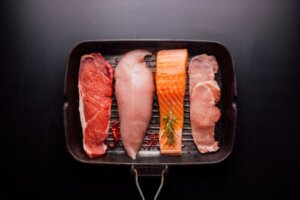Which Meats Are the Least Fattening?


Written and verified by the nutritionist Maria Patricia Pinero Corredor
Meats are the muscular parts of animals that are rich in protein and low in carbohydrates. The amount of fat varies according to the animal and the part of it consumed. Today, the trend is to choose the least fattening meats in healthy eating plans.
It’s common to find that the meats with the least fat are represented by skinless poultry. However, there are other less common animal species whose meats are also low in fat.
Keep reading to discover the meats that are the least fattening and therefore recommended for a healthier, nutrient-packed diet.
We think you may also enjoy reading this article: Here’s How to Eat Well if You Want to Cut Out Meat
What is meat?
According to the Spanish Food Code, meat is the soft edible part of cattle, sheep, pigs, and poultry. Animals are slaughtered under hygienic conditions for their meat. This includes fat, cartilage, skin, tendons, blood, and lymphatic vessels that are part of the muscle tissue.
Its chemical components vary according to breed, sex, type of cut, age, species, and the animal’s diet. Among them, the most outstanding are the proteins, which oscillate between 16 and 22 %; and the fat, whose values go from 1 to 15 %.
This amplitude in the amounts of fat allows us to classify the meats into the category of lean, when they have less than 5 % of fat, and into the category of fat, when they possess up to 30 % (as it is the case of the Iberian pig).
Nutritional value
Meat contributes to satisfying the nutritional necessities of the man. Its main nutrients are proteins, with a high proportion of essential amino acids.
Meat fat contains oleic fatty acid, similar to olive oil. This is followed in proportion by saturated fatty acids, which can contribute to clogging the arteries, and unsaturated fatty acids, which are essential for nutrition.
We also find highly bioavailable minerals, such as iron and zinc. As well as B complex vitamins.
However, despite being a very nutritious food, many people restrict their meat consumption. Meanwhile, some organizations suggest that meat should occupy less than 30% of the calories in the diet. In this sense, the United States Department of Agriculture recommends lean proteins to reduce obesity and overweight.

The least fattening meats
There are many types of meat with high-fat content, but some with low saturated fat values are also available in the market. Here are the least fattening meats for you to consider as part of a low-calorie diet and a healthier diet.
1. Horse meat
Horse meat is one of the red meats with the lowest proportion of fat since it contains barely 1 gram per 100 of product. Together with proteins, it adds up to about 100 calories, which is less than the caloric content of pork, chicken, and beef.
It also contains other nutrients, such as proteins, which are a source of 40% of essential amino acids. Its heme iron is highly bioavailable, since 15 to 30% is well absorbed, as is zinc.
2. Quail
Quail belong to the small migratory bird species. It adapts well to temperate or warm climates of the tropical or subtropical world.
One serving of quail provides 85% of the recommended protein intake for an adult male. This meat has less than 2 grams of fat per 100 grams of product. For this reason, its caloric value is very low, with only 106 calories in 100 grams.
Minerals, such as iron, phosphorus, and selenium, stand out among the nutrients in this type of meat. The most important water-soluble vitamins are niacin and vitamin B6. Currently, a consumption of 3 servings per week of lean meat is recommended, so quail could help you to meet this recommendation.
3. Ostrich
Ostrich meat is very similar in taste and texture to beef, but with less fat, since it only has 2%. Most of its fatty acids are essential in nutrition. It also has B complex vitamins, which help with the metabolism of the rest of the macronutrients.
4. Kangaroo
Although in many parts of the world this is little consumed as meat, it’s very popular in Australia. Likewise, in Spain, kangaroo meat is part of certain types of gourmet cuisine.
It’s considered red meat with very low fat value, since it only has 1.3 grams per 100 of product. That same portion provides 102 calories and 23 grams of protein.
5. Emu
Emu is a type of red meat similar to ostrich. It is 97% fat-free and is a low-calorie option. It stands out because it provides protein, iron, and vitamin B12.
6. Alligator
Talking about the least fattening meats is also thinking about non-traditional protein foods, such as alligator meat. Its low-fat content is mostly unsaturated, which makes it favorable to oxidative rancidity. However, it’s also a source of omega-3, which promotes cardiovascular health.
In fact, a study on the chemical composition of lean crocodile meat(Caiman Crocodylus Fuscus) indicates that it contains 21.46% protein, 0.72% fat, 1.26% minerals. However, it’s necessary to make sure to consume the meat which is not from the tail, since this can have up to 14 % fat.
7. Rabbit
A distinction should be made between wild rabbit and domestic rabbit, since the latter tends to have more fat and contributes more calories. In the case of the wild rabbit, its fat value is below 5 per 100 grams of meat. The proteins found in this type of meat are around 23% and are highly digestible.
Like other types of white meat, it provides many B vitamins, iron, zinc, magnesium, potassium, and phosphorus. It’s also low in sodium, making it favorable for the control and prevention of high blood pressure.

8. Turkey
Like chicken, it’s recommended to remove the skin of the turkey before preparing it. This is a type of white meat with 2% myofibrillar fat and 22% protein.
Turkey meat is a very good source of magnesium, zinc, potassium, phosphorus, and selenium. Among the vitamins, niacin, B6, and B12 stand out.
Like this article? You may also like to read: Imitation Crab Meat: Do You Know What It’s Made Of?
9. Deer
This is a type of dark red-brown meat, with a more intense tone than beef, but with less fat. It’s highly appreciated in the world of big game hunting and in gastronomy.
It provides 22% of proteins of high biological value, and the intramuscular fat content is only 1.6%. Consequently, it also has a low cholesterol value.
The low proportion of fat is responsible for its low-calorie content. Iron, zinc, and B-complex vitamins are the main micronutrients in venison.
10. Chicken
There’s no doubt that chicken is a favorite among the least fattening meats. In addition, there are many preparations that can be made with it, especially with the breast. It can be described as high quality protein, water-soluble vitamins, and low in calories.
Chicken breast contains almost 24% protein in 100 grams of product; 1.4 grams of fat, and 1.2 grams of minerals. Consuming 100 grams of breast barely provides us with 107 calories.
Culinary aspects for the least fattening meats
In the list of the least fattening meats, we must add a factor that will define the total contribution of calories: the type of preparation. Preliminary cleaning operations should be taken care of, such as the removal of skin, visible fat, or inedible tissue.
Likewise, both the cooking method and the accompanying ingredients are very important. For example, grilling, broiling, baking, and sautéing are recommended.
In any case, only a minimum amount of oil should be used. For a portion of between 120 and 150 grams of lean meat, one tablespoon of olive, canola, sunflower, or soybean oil may be used.
Non-starchy vegetables may be used as a side dish. Season with spices and natural herbs.
It’s recommended to consume three servings of low-fat meat per week.
All cited sources were thoroughly reviewed by our team to ensure their quality, reliability, currency, and validity. The bibliography of this article was considered reliable and of academic or scientific accuracy.
- Fundación Española del Corazón. Alimentos. Carne. Disponible en: https://fundaciondelcorazon.com/nutricion/alimentos/792-carne.html
- Teira, Gustavo; Perlo, Flavia; Bonato, Patricia; Tisocco, Osvaldo Calidad de carnes bovinas. Aspectos nutritivos y organolépticos relacionados con sistemas de alimentación y prácticas de elaboración Ciencia, Docencia y Tecnología, vol. XVII, núm. 33, noviembre, 2006, pp. 173-193. Disponible en: https://www.redalyc.org/pdf/145/14503307.pdf
- United States Departament of Agriculture. USDA. Elija alimentos con proteínas magras. Disponible en: https://snaped.fns.usda.gov/sites/default/files/documents/ESfamilymeals_lookforleanproteinfoods.pdf
- Organización de las Naciones Unidas para la Alimentación y la Agricultura. FAO. Grasas y ácidos grasos en nutrición humana Consulta de expertos. 2008. Disponible en: https://www.fao.org/3/i1953s/i1953s.pdf
- Mundo veterinario. Una revisión sobre el emú, su producción y patología. Disponible en: https://www.mapa.gob.es/ministerio/pags/Biblioteca/Revistas/pdf_MG%2FMG_1998_104_70_77.pdf
- Bustacara P, Joya T. Elaboración de tres productos cárnicos: Chorizo, Longaniza y Hamburguesa, con 100% carne de Babilla. [Tesis de Pregrado], [Bogotá, Colombia]: Universidad de la Salle. 2007. Disponible en: https://www.proquest.com/openview/ff47819597fb991d832a81472fb3c754/1.pdf?pq-origsite=gscholar&cbl=1806352
- Armando ALVIS, Pedro ROMERO , Carlos GARCIA. CARACTERIZACIÓN DE LA CARNE DE BABILLA (Caimán Crocodylus Fuscus) EN CAUTIVERIO. Vitae 23 (Supl. 1); 2016. Disponible en: https://www.proquest.com/openview/ff47819597fb991d832a81472fb3c754/1.pdf?pq-origsite=gscholar&cbl=1806352
- Conejo. Rabbit. Disponible en: https://www.mapa.gob.es/es/ministerio/servicios/informacion/conejo_tcm30-102481.pdf
- Ciervo. Deer Cervus. Disponible en: https://www.mapa.gob.es/es/ministerio/servicios/informacion/ciervo_tcm30-103063.pdf
- Claudia I. Gallinger, Francisco J. Federico, Bioq. Darío G. Pighin, Nadina Cazaux, Mariana Trossero, Agustina Marsó, Carlos Sinesi. Determinación de la composición nutricional de la carne de pollo argentina. diaeta (B.Aires) 2016; 34(156):10-18. Disponible en: https://inta.gob.ar/sites/default/files/20161227_-_inta_-_determinacion_nutric._carne_pollo_arg.pdf
This text is provided for informational purposes only and does not replace consultation with a professional. If in doubt, consult your specialist.








